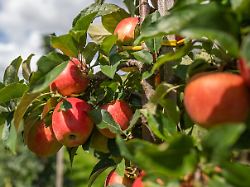First rain, then heat
Capricious weather will spoil the 2023 apple harvest
January 8, 2024, 4:06 p.m
Listen to article
This audio version was artificially generated. More info | Send feedback
Wet and cold weather first affects the apple blossom, heat and drought then do the rest for the trees: the apple harvest in 2023 will be worse than it has rarely been in the past decade. But overall, fruit remains extremely important in Germany.
The apple harvest was below average last year. At around 941,200 tonnes, 4.1 percent less was harvested than the average of the previous ten years, as the Federal Statistical Office in Wiesbaden announced. The plum harvest was also 3.7 percent below average.
For apples, the 2023 harvest year is the third worst of the past decade. Even fewer apples fell in 2017 with 596,700 tons and in 2013 with 803,800 tons. “The apple is still by far the most harvested tree fruit in Germany,” the statisticians emphasized.
The poor harvest was primarily due to unfavorable weather conditions. “The wet and cold weather at the time of flowering had a negative impact on pollination and sometimes led to frost damage.” In early summer, heat and drought left their mark, along with illnesses and local heavy rain and hail.
The majority is marketed as table fruit
According to the statistics office, almost three quarters of the 2023 apple harvest was marketed as table fruit. Almost a quarter went into the production of fruit juice, preserves and cider. “The remaining balance (1.6 percent) could not be marketed due to storage or processing losses.”
43,800 tons of plums and plums were harvested, 86.5 percent of them for marketing as table fruit. “Due to unfavorable weather conditions, pest infestation and fruit bursting caused by rain, yield losses occurred in some regions,” the statistics office said. At 3.6 percent, the proportion of non-marketable fruits was higher than apples.
In 2023, apples accounted for 88.1 percent of the total recorded tree fruit harvest. This was followed by plums and plums with 4.1 percent, pears with 3.5 percent and sweet cherries with 3.0 percent.
